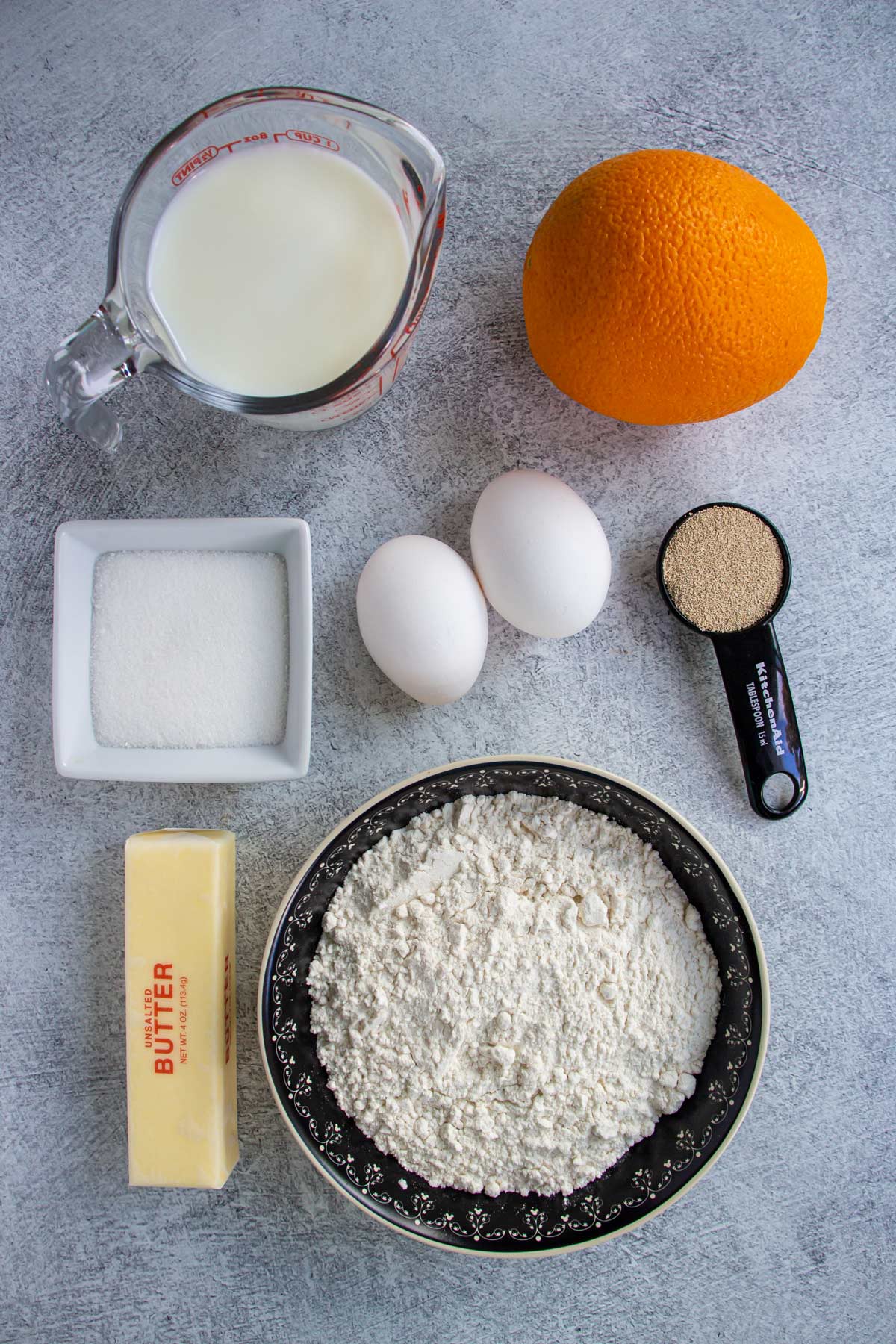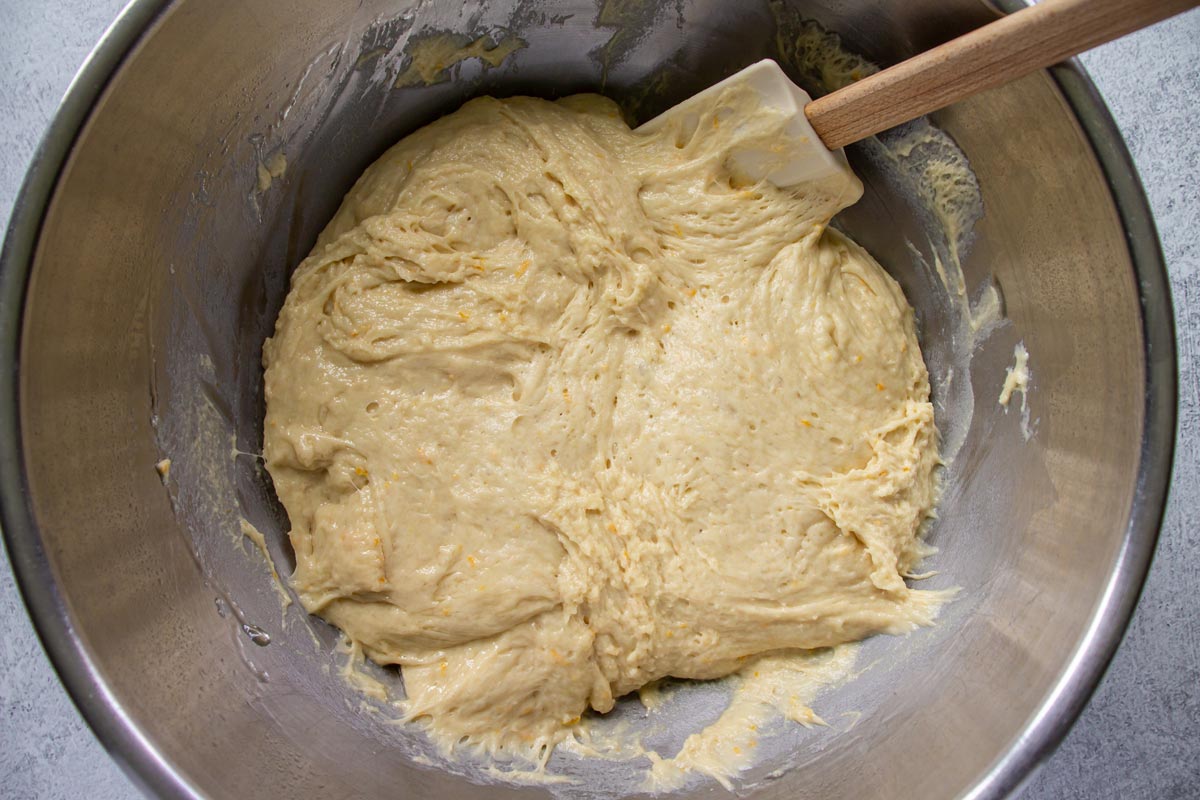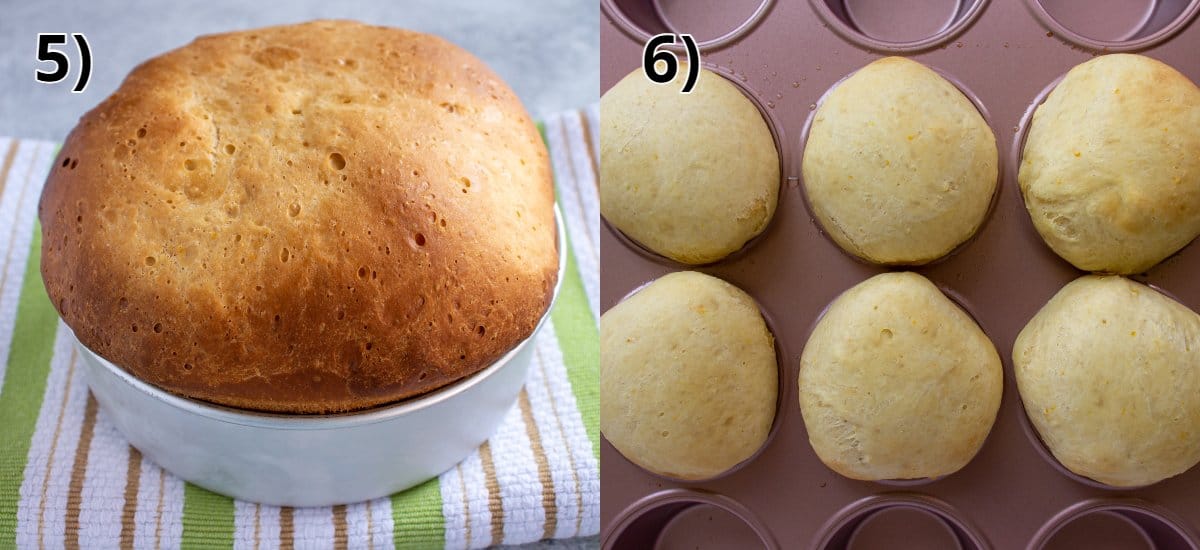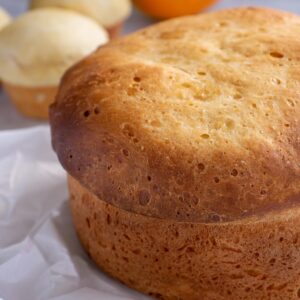Sally Lunn Buns are classic enriched breads from Bath, England. They're buttery and not too sweet with a hint of citrus flavor and a delicate, soft, spongey crumb. Enjoy them sliced or halved (like a hamburger bun) on their own or with butter and jam.

Sally Lunn is a large bun or tea cake, somewhat similar to French brioche. They're sometimes also called Solange Luyon Buns or Solilemmes. These tea time treats are great for breakfast as well, featuring a light, airy crumb, buttery aroma, and light essence of citrus.
Sally Lunn is sometimes called a bun and sometimes a cake. It's essentially an enriched bread in the shape of a mushroom with an overhanging cap (a bit like a muffin top). Even the large loaves are called buns, though they are arguably too substantial for that diminutive term.
They most notably hail from the British spa town of Bath. Sally Lunns are sometimes mistakenly confused with Bath buns, which are sweeter and filled with currants and topped with pearl sugar.
These famous buns have been mentioned in books by Charles Dickens and William Makepeace Thackeray, and by Jane Austen. She claimed they were too rich and heavy and were bad for her digestion, but I think they're fantastic and absolutely melt-in-your-mouth! They're also considerably easy to make, and you don't even have to shape them like traditional loaves of bread.

Mysterious origins
The origins of these beloved buns are unclear, with several different stories of how they came to be.
The Sally Lunn Eating House in Bath, England, claims that the recipe was brought to Bath in the 1680s by a Huguenot refugee from France. Her name was Solange Luyon, but became known as Sally Lunn, an anglicized version of her name. Though this theory is the most romantic, there is little historical evidence of Solange Luyon's existence, or of Sally Lunn being the name of an actual person.
Another theory claims that a young woman was peddling her basket of buns on a Bath street, and cried out in French “soleil lune," which sounds a bit like “Sally Lunn” to the English ear. Soleil lune translates as sun moon, describing the golden crust (sun) and the round shape and white interior (moon) of these buns. This is a more realistic possibility.
There are also references to French buns or cakes called Solilemmes, a name sometimes used interchangeably for Sally Lunn buns. These are a type of warm brioche popularized by Parisian chef Marie-Antoine Carême in 1815. He claimed the recipe originated in Alsace but this assertion lacks evidence. It's more likely he got the idea for the recipe from contacts in Bath, then attempted to disguise its origins, as Britain was France's great enemy at the time.
Ingredient notes

- Yeast: This Sally Lunn buns recipe uses instant yeast, sometimes called rapid rise yeast. I have not tested it with different types of yeast, however here is a general substitution if using active dry yeast. First combine the active dry yeast with the lukewarm milk and butter mixture to allow it to bloom. After a few minutes once it dissolves and starts to get frothy, add it to the dry ingredients mixture. Proceed with the recipe as directed.
- Milk: Use your preferred type of milk in this recipe. I usually use low-fat milk because that's what I like to buy. You'll get a richer flavor with whole milk if you have it.
- Flour: All-purpose (plain) flour works well in this recipe. No need to use special bread flour.
- Zest: You may use freshly grated orange or lemon zest for these Sally Lunn buns. Use a fine rasp grater like a Microplane to remove only the orange or yellow part of the zest, and not the bitter white pith beneath it. You’ll need the zest from about ½ a naval orange or 1 lemon to yield enough for the recipe. You could also increase the amount of zest if you prefer.

How to make it
Add the milk to a saucepan and bring to a simmer over low heat. Remove from the heat, add the butter and stir to dissolve and melt. Set the mixture aside to cool to lukewarm.
Meanwhile, to the bowl of an electric mixer fitted with the paddle attachment add the flour, sugar, and instant yeast and just stir to combine for about 30 seconds.
Add the lukewarm milk and butter mixture, the beaten eggs, orange zest, and salt (PHOTO 1). Mix on medium speed for about 6 minutes until smooth and elastic but still very wet and sticky. It will look like thick and stretchy cake batter (PHOTO 2).

Scrape the batter into a very large greased bowl, large enough for the dough to double in size (PHOTO 3). Cover the bowl with plastic wrap and set it in a slightly warm, draft free spot until the dough is doubled in size, about 60 to 90 minutes (PHOTO 4).

After the dough has doubled in size, punch down the dough to deflate it. It may be very sticky so you may lightly oil your hands if needed as you work with it, or use a rubber spatula.

Either divide the dough between 2 greased round cake pans (6 inches / 15 cm in diameter) or divide into 12 to 18 cups in a greased standard muffin pan to make individual tea buns.

Cover the pans loosely with greased plastic wrap and set aside in a warm, draft free place. Proof in the pan for another 30 minutes for the cake pans or 10 to 15 minutes for the muffin pan, until the dough rises in a dome over the top of the pans.

Preheat the oven to 375°F (190°C). Bake large buns for about 30 minutes, or about 12 to 15 minutes for the smaller tea buns in the muffin pan (PHOTOS 5-6).

Let the Sally Lunn buns cool in the pans for about 5 minutes. Carefully remove from the pans and continue to cool on a wire rack.
Please scroll to the bottom of the post for the full recipe (in a printable recipe card) including ingredient amounts and detailed instructions.

Expert tips
Sally Lunn is a "batter bread," meaning it is very high hydration (more liquid than flour) yielding a very wet and soft dough or batter. For this reason, a paddle works better than a dough hook when mixing it. You must beat the batter for several minutes to develop the gluten, rather than traditionally kneading it.
These buns will stay fresh in an airtight container or wrapped tightly in foil at room temperature for about 3 to 4 days before they start to change their texture.
To serve, slice the large bun like a standard loaf of bread or halve the smaller tea buns (or the large one too if you prefer) like hamburger buns—at the equator. Toast the slices or halves or leave them untoasted. Enjoy as is or serve with butter and jam. You may also serve with savory toppings if you prefer.

For accuracy when dividing the dough, you can weigh it. Weigh the total and then just divide it by the number of pieces. I had about 940 grams of dough, and put 470 grams in a 6-inch round cake pan and about 78 grams into each of 6 cups in a standard muffin pan. This made 1 large bun and 6 small tea buns. You could also make slightly smaller tea buns in muffin pans and weigh them at around 50 grams each to yield 18 total (or 9 for half the batter).
I feel the dough is too soft to really shape the smaller tea buns into more perfect round shapes. It's also much easier to just divide evenly into the muffin cups, however you could certainly try. I don't mind their rustic appearance.
If your large Sally Lunn buns brown too quickly, tent the top loosely with foil partway through baking. The smaller tea buns will not brown as much as the larger ones because they bake so quickly. You can bake them longer to brown them, but I didn't want to dry them out so I didn't.

Other recipes you may like
- The Ritz of London's Afternoon Tea Scones
- Rock Cakes
- Cherry Bakewell Cake
- Afternoon Tea Sandwiches (Cucumber, Egg and Cress, Smoked Salmon)
- Buchteln (Austrian Stuffed Sweet Rolls)
- Chorek / Choreg (Armenian Sweet Bread)
- Viennoise au Chocolat (Vienna Bread with Chocolate)
- Zopf / Butterzopf (Swiss Braided Bread)
- French Brioche Bread
Tried this recipe? Please leave a star ⭐️⭐️⭐️⭐️⭐️ rating in the recipe card below and/or a review in the comments section further down the page. You can also follow me on social media on Facebook, Instagram, and Pinterest!

Sally Lunn Buns (Solange Luyon Buns or Solilemmes)
Ingredients
- 1 ¼ cups (280 ml) milk
- 6 tablespoons (85 grams) unsalted butter
- 3 ¾ cups (450 grams) all-purpose flour
- ¼ cup (50 grams) granulated sugar
- 1 tablespoon (10 grams) instant yeast
- 2 large eggs, beaten
- 1 ½ teaspoons freshly grated orange or lemon zest
- 1 teaspoon salt
Instructions
- Add the milk to a saucepan and bring to a simmer over low heat to about 180°F (82°C) but do not boil. Remove from the heat, add the butter and stir to dissolve and melt. Set the mixture aside to cool to lukewarm, about 100°F to 110°F (38°C to 43°C).
- Meanwhile, to the bowl of an electric mixer fitted with the paddle attachment add the flour, sugar, and instant yeast and just stir to combine for about 30 seconds.
- Add the lukewarm milk and butter mixture, the beaten eggs, orange zest, and salt and mix on medium speed (#4 on a Kitchenaid mixer) for about 6 minutes until smooth and elastic but still very wet and sticky. It will look like thick and stretchy cake batter.
- Scrape the batter into a very large greased bowl, large enough for the dough to double in size. Cover the bowl with plastic wrap and set it in a slightly warm, draft free spot until the dough is doubled in size, about 60 to 90 minutes.
- After the dough has doubled in size, punch down the dough to deflate it. It may be very sticky so you may lightly oil your hands if needed as you work with it, or use a rubber spatula.
- Either divide the dough between 2 greased round cake pans (6 inches / 15 cm in diameter) or divide into 12 to 18 cups in a greased standard muffin pan to make individual tea buns (divide up evenly between 2 muffin pans if making 18). With oiled fingers, you can lightly pat or smooth out the tops of the dough if they look too lumpy (depending on how you filled them).
- Cover the pans loosely with greased plastic wrap and set aside in a warm, draft free place to proof in the pan for another 30 minutes for the cake pans or 10 to 15 minutes for the muffin pan, until the dough rises in a dome over the top of the pans.
- Preheat the oven to 375°F (190°C). Bake large buns for about 30 minutes, (tenting the top loosely with foil if needed if it browns too quickly), or about 12 to 15 minutes for the smaller tea buns in the muffin pan. The internal temperature with an instant read thermometer should be about 205°F (96°C) for either size of bun. The smaller buns will not brown as much as the larger ones because they bake so quickly.
- Let the buns cool in the pans for about 5 minutes, then carefully remove from the pans and continue to cool on a wire rack.
Notes
- Sally Lunn is a "batter bread," meaning it is very high hydration (more liquid than flour) yielding a very wet and soft dough or batter. For this reason, a paddle works better than a dough hook when mixing it. You must beat the batter for several minutes to develop the gluten, rather than traditionally kneading it.
- These buns will stay fresh in an airtight container or wrapped tightly in foil at room temperature for about 3 to 4 days before they start to change their texture.
- For accuracy when dividing the dough, you can weigh it (weigh the total and then just divide it by the number of pieces). I had about 940 grams of dough, and put 470 grams in a 6-inch round cake pan and about 78 grams into each of 6 cups in a standard muffin pan to make 1 large bun and 6 small tea buns. You could also make slightly smaller tea buns in muffin pans and weigh them at around 50 grams each to yield 18 total (or 9 for half the batter).
- To serve, slice the large bun like a standard loaf of bread or halve the smaller tea buns (or the large one too if you prefer) like hamburger buns—at the equator. Toast the slices or halves or leave them untoasted. Enjoy as is or serve with butter and jam. You may also serve with savory toppings if you prefer.
Nutrition
*All nutritional information is based on third-party calculations and should be considered estimates. Actual nutritional content will vary with brands used, measuring methods, portion sizes and more.*






Comments
No Comments